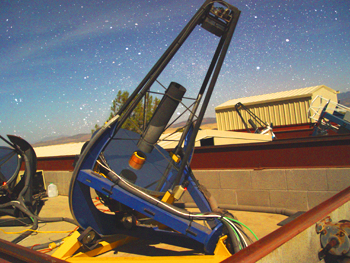T8 0.80 meter APT

Observing Program
The T8 0.80m APT began high-precision observations of solar-type stars in April 1996 at the Fairborn Observatory APT site on Mt. Hopkins in southern Arizona. The telescope was relocated during the summer of 1996 to Fairborn's new site at 5500 ft in the Patagonia mountains near Washington Camp, Arizona. Operation of the 0.80m APT is funded by NASA, NSF, and Tennessee State University.
The 0.80m APT is dedicated to long-term photometric monitoring of approximately 75 solar-type stars, an observing effort that extends the program of the T4 0.75m APT. The stars observed by the T8 APT have been chosen to be close to the Sun in mass and age; most lie between spectral types F8 V and G5 V. These stars were also monitored contemporaneously by the Mount Wilson HK Project until the end of 2003 to determine their levels of magnetic activity. The APT observations are made differentially with respect to three comparison stars carefully chosen for high photometric stability. Extensive quality control and calibration measurements with the APT result in an external precision of 0.0010 mag for a single observation and 0.0001 mag for seasonal means. At this level of precision, the telescope is able to follow long-term brightness changes in Sun-like stars that are analogous to the subtle long-term brightness changes in our Sun observed with space-based radiometers. The Sun's brightness varies by roughly 0.001 mag in step with the sunspot cycle. Therefore, the APT measurements of solar-type stars, combined with the observations of the stars' magnetic activity from Mount Wilson, should provide greater insight into the relationship between magnetic cycles and brightness changes in a variety of stars.
Several of the stars on the observing menu of the 0.80m APT have been discovered to have planets in orbit around them. Since these discoveries have been made indirectly with radial-velocity techniques, complementary observations are required to confirm the existence of these planets. For instance, the observed radial-velocity variations might actually arise from surface magnetic activity or stellar pulsations, both of which would be expected to give rise to small but measurable photometric variations. Therefore, the precise brightness measurements made with the 0.80m APT are important for understanding the nature of the observed radial-velocity variations and confirming the reality of the planetary discoveries. The 0.80m APT is also monitoring these stars to search for transits of the planetary companions. The detection of transits, combined with the radial-velocity observations, allows the determination of the planet's true mass, its size, and its mean density. This provides important clues to the planet's composition and origin. The long-term photometric observations of these stars will also reveal which of them have the stable energy output required for life to exist on suitable planets.
Specifications
- Pyrex 31.5-inch Cassegrain optics from Star Instruments
- Primary mirror focal ratio is f/2
- Secondary mirror diameter is 8 inches
- Effective focal ratio is f/8
- Horseshoe equatorial mount design by Fairborn Observatory
- Mechanical fabrication by Rettig Machine Shop of Redlands, California
- Micro-stepping Berg belt to disk & roller drives on both axes
- High-precision, two-channel photometer with dichroic beam splitter from Fairborn Observatory
- Stromgren by filters
- Neutral density filters with attenuation of approximately 1.25, 2.5, 3.75, and 5.0 mag.
- Selectable diaphragm wheel with diameters of 30, 45, 60, & 90 arcseconds
- Two EMI 9124QB photomultipliers running at 1200V and +4 degrees C
- Photomultiplier, voltage divider, preamp, and filters in sealed environmentally controlled chamber
- ATIS93 automatic control system by Fairborn Observatory
- External precision of a single observation is 0.0010 mag, 0.0001 - 0.0002 for seasonal means
